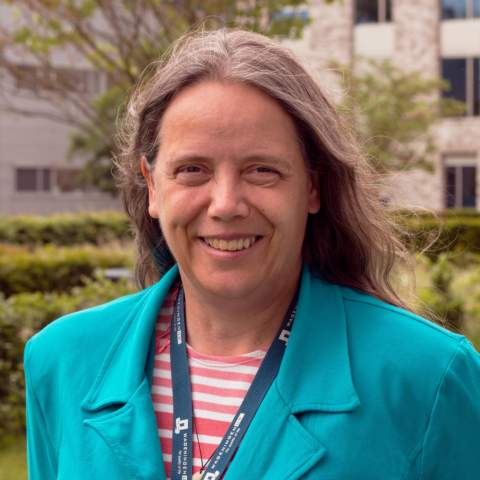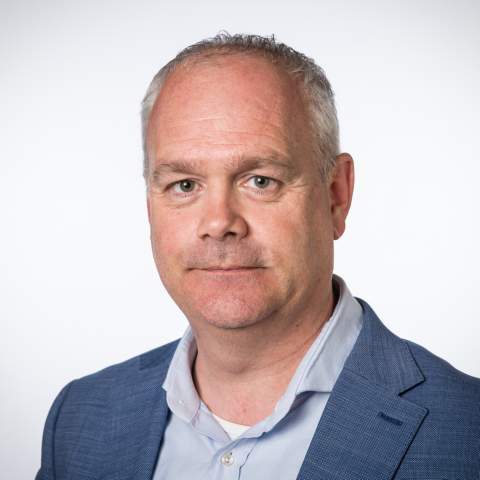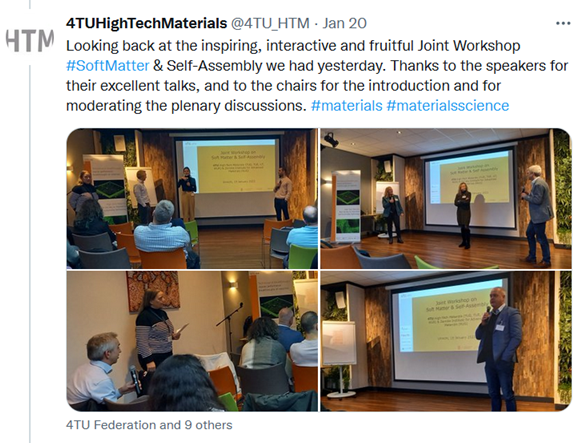Soft Matter & Self-Assembly
Joint 4TU.HTM, M2i & Zernike Institute for Advanced Materials workshop. We invited scientists with interest and expertise in soft matter including its assembly, to exchange knowledge, and explore ways of collaboration.
Aim of the worshop
Soft matter surrounds us in our daily lives, and are omni-present i.e., foods, polymers, plants, humans. Often these materials are formed through a complex sequence of self-assembly processes. In this workshop we did not only highlight the importance of soft matter materials in addressing societal challenges, we also elaborated on their underlying mechanism through a dedicated line-up of researchers.
Programme
The programme consisted of presentations and plenary discussions on the following topics:
Emulsions, Adhesives, Polymeric layers, Self-Assembly
Fundamental aspects versus Applications
Prof.dr.ir. Jasper van der Gucht - keynote speaker
 Professor of Physical Chemistry and Soft Matter, WUR
Professor of Physical Chemistry and Soft Matter, WUR
Presentation
When gels become unstable: yielding and syneresis in colloidal networks (Pdf file, 15 MB)
With his group Jasper van der Gucht works on soft networks, gels, and composite materials that are formed by the spontaneous organization (or self-assembly) of macromolecules or colloidal particles. In this lecture, Jasper will focus on colloidal gels, networks formed by attractive particles or droplets. Such networks are abundant in household products, foods, and ceramics. In particular he will discuss recent results on the stability of such gels, under external stress (yielding) or under the internal stresses that arise during gelation (syneresis).
Prof.dr.ir. Wiebe de Vos
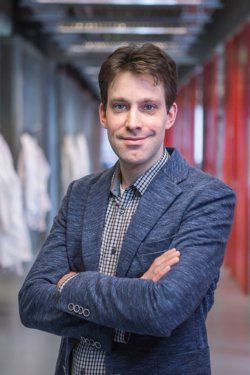 Professor of Membrane Surface Science, UTwente
Professor of Membrane Surface Science, UTwente
Presentation
Asymmetric polyelectrolyte multilayers for clean water production (Pdf file, 2 MB)
Abstract
Within his group Prof. de Vos successfully combines his background in the fundamentals of colloid and surface science with the much more applied field of membranes. His work in encompasses the coating of membranes for various functional enhancements, including anti-fouling, enhanced separations, easy-to-clean membranes and virus in-activation, but also entails the production of membranes using sustainable approaches such as aqueous phase separation. In this talk, the focus will be on how smart application of polyelectrolyte multilayers can allow the fabrication of highly promising membranes, that effectively remove small organic pollutants from water.
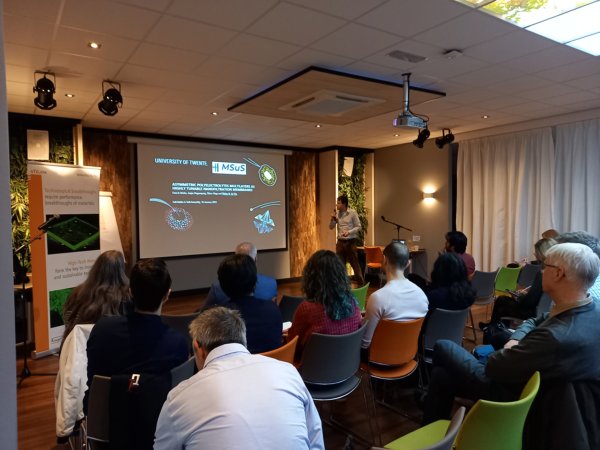
References
- Brinke, te, E.; Reurink, D. M.; Achterhuis, I.; de Grooth, J.; de Vos, W. M., Asymmetric polyelectrolyte multilayer membranes with ultrathin separation layers for highly efficient micropollutant removal, Applied Materials Today 2020, 18, 100471
- Baig, M. I.; Durmaz, E. N.; Willott, J. D.; de Vos, W. M., Sustainable Membrane Production through Polyelectrolyte Complexation Induced Aqueous Phase Separation, Advanced Functional Materials 2020, 30 (5), 1907344
Dr. Siddharth Deshpande
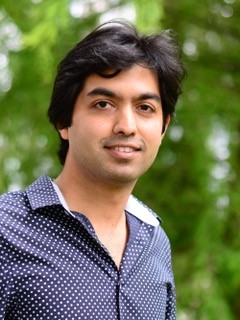 Assistant Professor in Emergent Biological Systems, Laboratory of Physical Chemistry and Soft Matter, WUR
Assistant Professor in Emergent Biological Systems, Laboratory of Physical Chemistry and Soft Matter, WUR
Presentation
Crystal-Gazing: Biosensing using colourful liquid crystals (Pdf file, 23 MB)
Abstract
In this talk, I will narrate our recent attempts to use liquid crystal droplets as microsensors to sense amphiphiles. We utilize chiral nematic liquid crystal microdroplets, which show strongly reflected structural colours, as sensing platforms. We systematically quantify the optical response of closely related biological amphiphiles and find unique optical signatures for each species. We show lab-on-a-chip capability of our method by drying droplets in two-dimensional arrays and hydrating the chip to detect dissolved analytes. Finally, we show proof-of-principle in vivo biosensing in the intestinal tracts of live zebrafish larvae, where the droplets show a clear optical response in healthy and inflamed tissues. Our results show the potential of liquid crystals in developing detection platforms and for in vivo detection of biomolecules.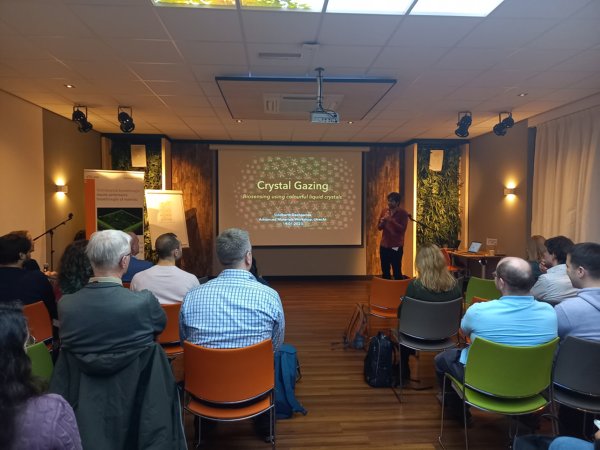
Reference
L.W. Honaker, C. Chen, F.M.H. Dautzenberg, S. Brugman, and S. Deshpande*. “Building biological microsensors with chiral nematic liquid crystal droplets” ACS Applied Materials and Interfaces, 14(33):37316-37329, 2022
Siddharth Deshpande is an interdisciplinary scientist fascinated by living systems. His passion is to understand how biomolecules self-assemble into functional structures and utilize these fundamental principles for bioengineering. His interests and expertise lie in biological soft matter (particularly liquid-liquid phase separation and membranes), synthetic biology, and on-chip microfluidic technology.
Armin Amirsadeghi, MSc
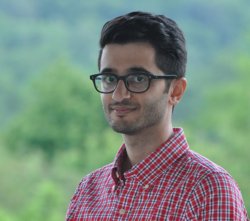 PhD Student, Polymer Science, Faculty of Science and Engineering, RUG
PhD Student, Polymer Science, Faculty of Science and Engineering, RUG
Title: Biopolymer complex coacervate 3D printable Bioink
Armin works with Prof. Marleen Kamperman. Their group uses biologically inspired strategies to develop polymeric materials for underwater adhesives and functional materials. 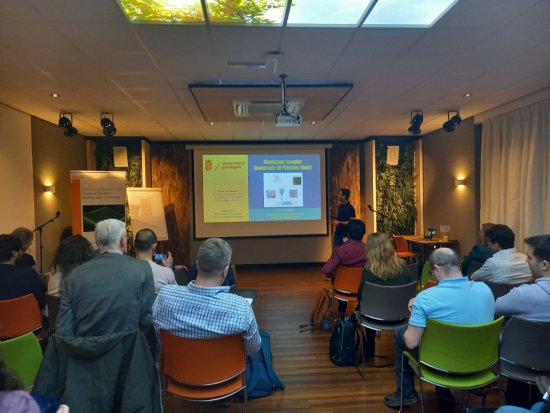
Dr. Georgy A. Filonenko
Assistant Professor in Polymers & Soft Materials, Materials Science and Engineering Department, TU Delft
Presentation
Molecular mechanochemistry for optical imaging of internal stresses in polymer films (Pdf file, 4 MB)
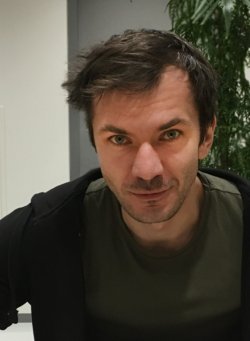 Abstract
Abstract
When polymers solidify they accumulate internal tensile and compressive stresses in their bulk and surface. These stress patterns affect mechanical performance of polymer devices. In the case of thin films they are one of the main reasons for defect formation and delamination. Few optical and spectroscopic methods for estimating internal stresses exist and they generally reflect macroscopic alignment, density or other physical aspects of the sample. In our work we use chemical reactions to track internal stresses. Since our feedback signal originates on the level of molecules we can perform structural studies using our technique. Being able to label any discrete location within the polymer, we could also examining the effects which topology has on stress perception. Ultimately, chemistry is our main tool in manipulating polymers and with current techniques we can start examining its molecular manifestations within real macroscopic materials.
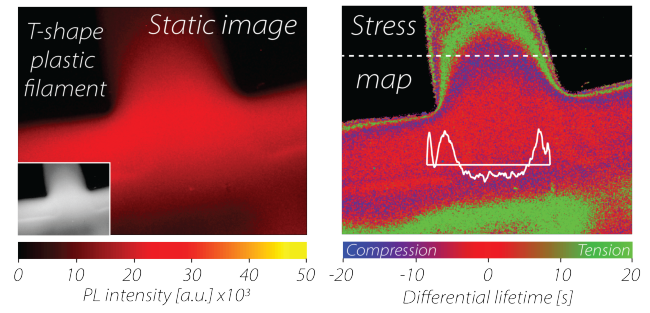
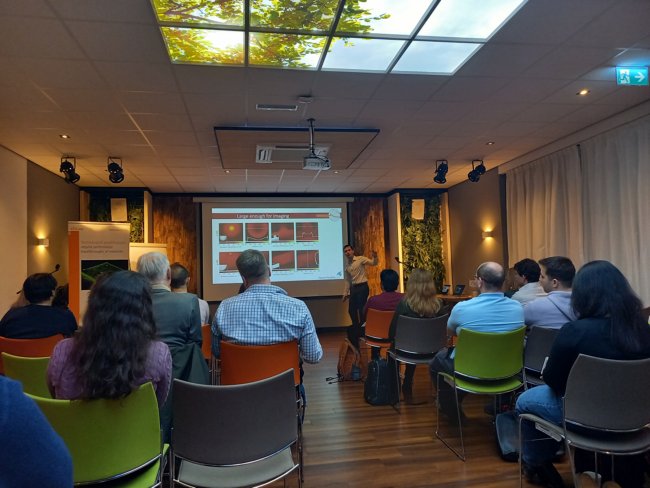
Dr. Julien Es Sayed
Postdoc Polymer Science, Zernike Institute of Advanced Materials, Science & Engineering, RUG
Presentation
Smart Emulsions using Responsive Pickering Emulsifiers (Pdf file, 2 MB)
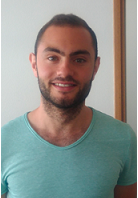 Abstract
Abstract
Pickering emulsions are emulsions stabilized by colloidal particles that are known to exhibit a high kinetic stability which make them promising candidates for a wide range of applications where long term storage is needed. However, when it comes to the development of so-called “smart emulsions” for which the destabilization of the emulsion and the release of the active components present in the dispersed phase should be triggered by an external stimulus, this high stability can become detrimental. In this talk, I will introduce the audience to two innovative Pickering emulsifiers that we designed which enable us to develop kinetically stable emulsions but which can be at the same time readily destabilized by action of an external stimulus.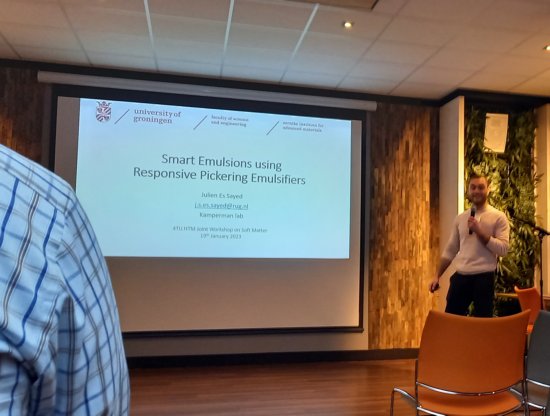
References
- Julien Es Sayed, Hugo Brummer, Marc C. A. Stuart, Nicolas Sanson, Patrick Perrin, and Marleen Kamperman, 'Responsive Pickering Emulsions Stabilized by Frozen Complex Coacervate Core Micelles', ACS Macro Lett. 2022, 11, 1, 20–25
- Julien Es Sayed, Christophe Meyer, Nicolas Sanson, and Patrick Perrin, 'Oxidation-Responsive Emulsions Stabilized by Cleavable Metallo-Supramolecular Cross-Linked Microgels', ACS Macro Lett. 2020, 9, 7, 1040–1045
Dr. Emma Hinderink
Postdoc Chemical Engineering at the Faculty of Applied Science, TU Delft
Presentation
Dynamic processes occurring during emulsion production: Insights from a microfluidic approach (Pdf file, 2 MB)
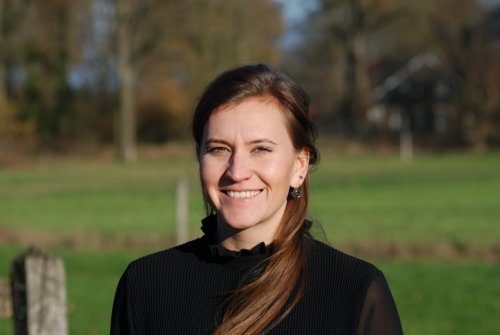 Abstract
Abstract
To understand the phenomena occurring during emulsification and downstream processing, effects that take place at the micron- and sub-second time scales need to be investigated. Emulsifiers are typically used to stabilise the newly formed droplets. Dependent on the type of emulsifier used, a viscoelastic interface layer may form that protects droplets against coalescence. Whether such a network, or at least its initial states, is already formed during production is instrumental to understand droplet stabilisation immediately after droplet formation. After emulsification, emulsions are further processed. During downstream processing emulsion droplets are subjected to non-uniform flows. Within such a flow, emulsion droplets can deform, break-up and coalesce, therewith affecting final product properties. At high dispersed phase fractions, one local coalescence event can propagate leading to a cascade of coalescence events therewith destabilising part of the entire droplet assembly. In this presentation, I introduce various microfluidic devices that enable to study emulsion stability and interfacial properties at the droplet level and at time scales relevant to industrial processes. Microfluidic experiments are combined with state-of-the-arte micro-particle tracking velocimetry to unravel the dynamic interplay between fluid flow and stability.
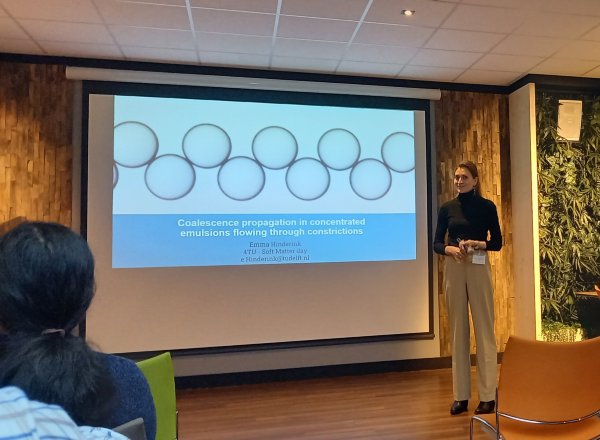
References
- Hinderink, E. B. A., Ruiter, J. De, Leeuw, J. De, Schroën, K., Sagis, L. M. C., & Berton-carabin, C. C. (2021). Early film formation in protein-stabilised emulsions: Insights from a microfluidic approach. Food Hydrocolloids, 118, 106785
Dr. Janne-Mieke Meijer
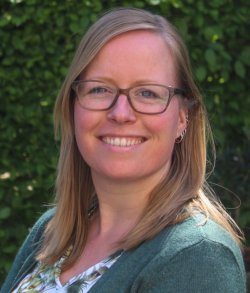 Assistant Professor in the Theory of Polymers & Soft Matter group, Applied Physics, TU Eindhoven
Assistant Professor in the Theory of Polymers & Soft Matter group, Applied Physics, TU Eindhoven
Presentation
Complex colloidal self-assembly: towards designer materials (Pdf file, 5 MB)
Abstract
To develop new materials with novel mechanical, optical or electronic functionalities control over matter on multiple length scales is needed. One of the most promising design strategies in material science is leveraging the spontaneously self-organization of molecular, nanoparticle and colloidal building blocks into larger complex superstructures. However, not all potential of these materials is currently exploited is because control over the self-assembly of the building blocks into the desired predesigned structures is still lacking. In this talk I will show how studying colloidal self-assembly with both quantitative microscopy and x-ray scattering techniques is uniquely powerful for visualizing the self-assembly on a single-particle level. I will address the influence of shape anisotropy as well as directed self-assembly on the final superstructures and defect dynamics. I will further show how by employing complex colloids we can gain new insights of the fundamental forces, mechanics and design principles that govern their self-assembly.
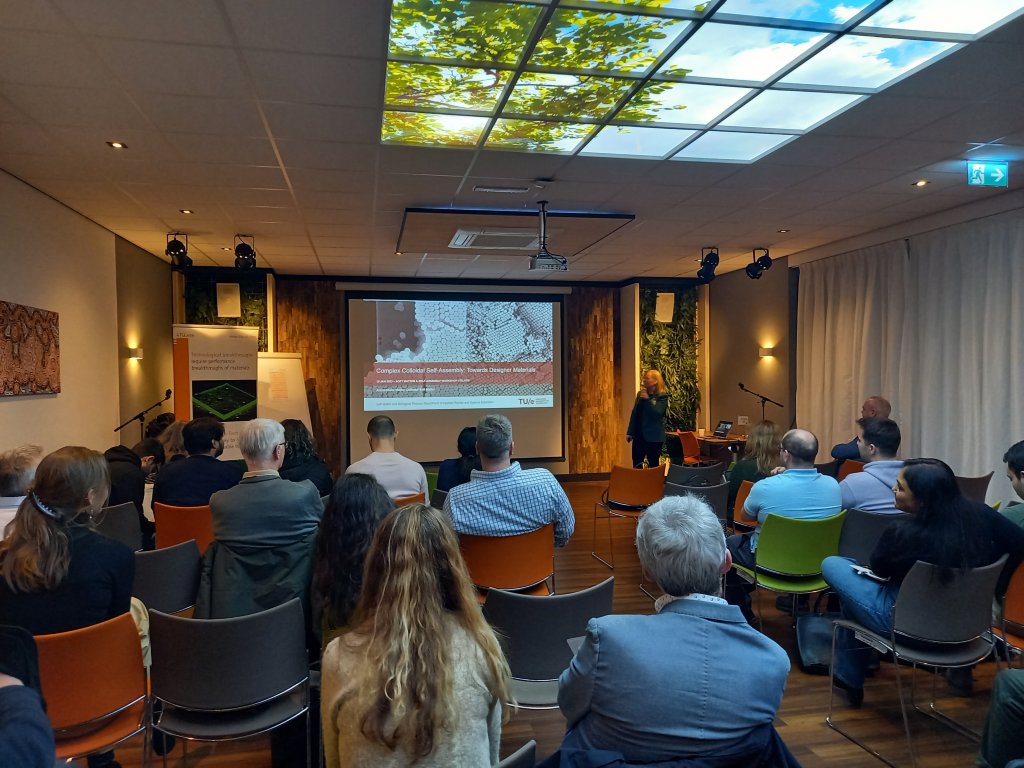
Dr. Julieta Paez
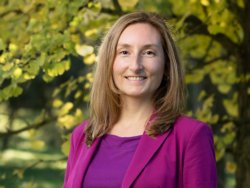 Assistant Professor, Developmental BioEngineering, Faculty of Science and Technology, UTwente
Assistant Professor, Developmental BioEngineering, Faculty of Science and Technology, UTwente
Title: Biomedical applications of bioinspired dynamic hydrogels
Abstract
Cell-encapsulating hydrogels are used as extracellular matrix mimics for tissue engineering applications. For synthetic hydrogels to mimic the native cell microenvironment more closely, molecular engineering aims at pre-programming smart properties in the design of these materials. One approach is the use of versatile coupling chemistries to engineer the network crosslinks. This allows to control basic properties in the system such as gelation rate, mechanics and bioactivity; and to confer advanced properties like self-healing, stimuli-responsiveness and adaptability.
I will present the use of bioinspired chemistry to molecularly engineer hydrogels with tunable viscoelastic properties for cell encapsulation. In a first molecular design, bioinspired covalent chemistry enables the fabrication of tunable and inexpensive hydrogels for 3D cell culture [1]. This platform exhibits advantages like rapid gelation rate and tunability of mechanical and biological properties. In a second molecular design, redox-responsive hydrogels widen the application range of this synthetic platform [2], by enabling to finely control the gelation onset and gelation rate, which can be used to modulate the injectability of these materials. Finally, I will present the development of reversible hydrogels with self-healing and stress-relaxing properties [3]. These bioinspired hydrogels are a robust and versatile platform for cell culture, enabling easy adjustment of properties to perform in diverse biomedical scenarios.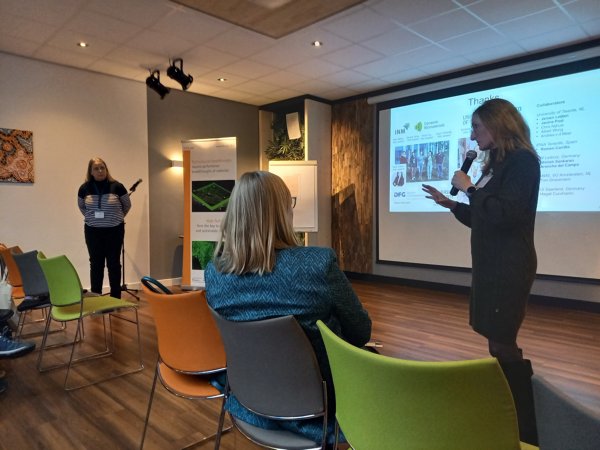
References
- Jin, M.; Kocer, G.; Paez, J.I. ACS Appl. Mater. Interfaces 2022, 14, 5017
- Jin, M.; Gläser, A.; Paez, J.I. Polym. Chem. 2022, 13, 5116
- Jin, M., Paez, J.I., under preparation
ResearchGate profile of Julieta Paz
Prof.dr.ir. Atze Jan van der Goot
Professor Sustainable Protein Technology, Food Process Engineering (WUR)
Title: Structuring of Food Products. What can we learn from soft matter physics?
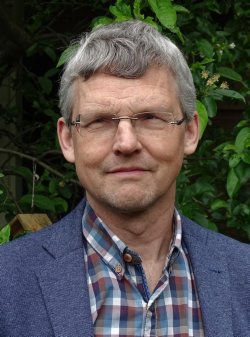 Abstract
Abstract
The creation of anisotropic and fibrous food products will be presented. These products can form the basis for next generation meat analogues. Meat analogues are made from plant and diary proteins, which can be transformed into anisotropic products when deformed in a well defined manner. However, not all proteins have the right properties to form anisotropic products. Here soft matter physics can help to better understand why certain proteins or protein aggregates form anisotropic products or others not. In addition, it can help to better understand protein-water interactions, which is essential to better control the texture properties of these products as well as their juiciness. Finally, developments will be highlighted of new analytical tools to quantify the anisotropy of these products.
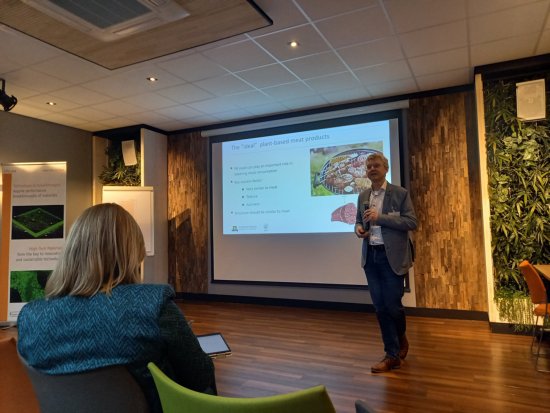
References
- S.H.V Cornet, S.J.E. Snel, F.K.G Schreuders, R.G.M van der Sman, M. Beyrer, A.J. van der Goot 2022¸ Thermo-mechanical processing of plant protein using shear cell and high-moisture extrusion cooking, Critical reviews in Food science and nutrition, 62(12): 3264–3280
- B. Tian, Z. Wang, L. de Campo, E.P. Gilbert, R.M. Dalgliesh, E. Velichko, A.J. van der Goot and W.G. Bouwman, 2020, Small angle neutron scattering quantifies the hierarchical structure in fibrous calcium caseinate, Food Hydrocolloids, 106: 105912
- B.L. Dekkers, R.M. Boom, A.J. van der Goot 2018, Structuring processes for meat analogues, Trends in Food Science and Technology, 81: 25–36
- J.M. Manski, A.J. van der Goot, R.M. Boom 2007, Advances in structure formation of anisotropic protein-rich foods through novel processing concepts, Trends in Food Science and Technology 18(11): 546-557
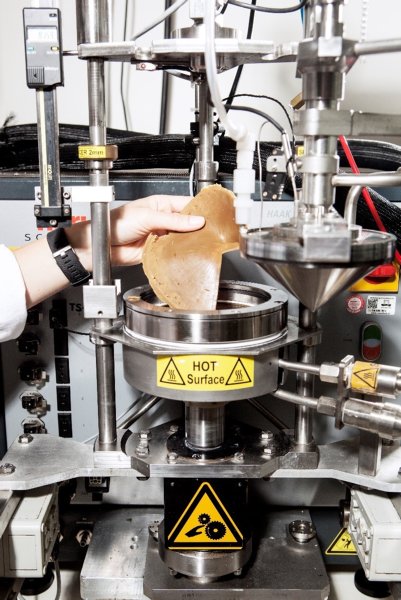
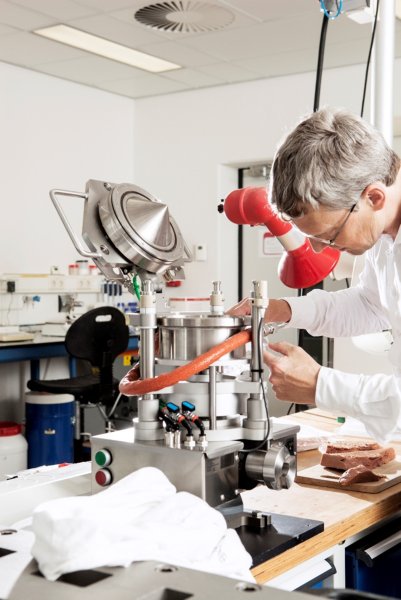
Plenary discussions
Wrapping up each session with a plenary discussion.
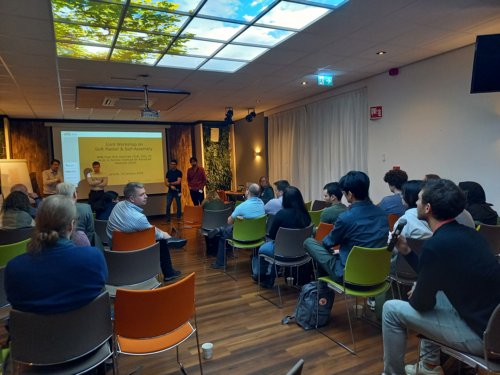
Wiebe de Vos, Georgy A. Filonenko, Armin Amirsadeghi, Siddharth Deshpande
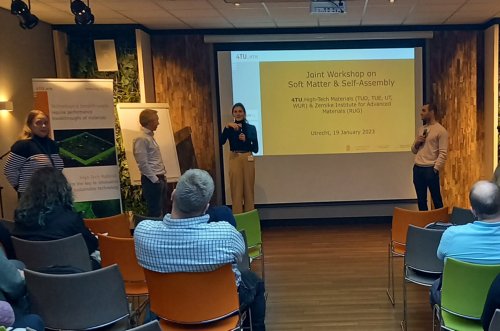
Karin Schroën (chair), Jasper van der Gucht, Emma Hinderink, Julien Es Sayed
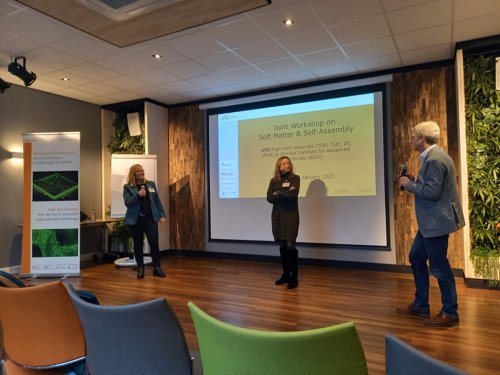
Janne-Mieke Meijer, Julieta Paez, Atze Jan van der Goot




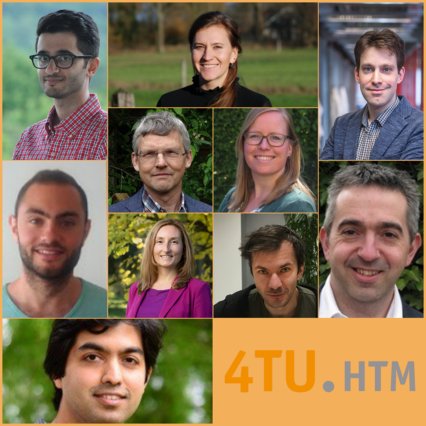 This event took place as an all-day live event in De Witte Vosch, Utrecht on Thursday 19 January 2023. Pictures and presentations can be found on this website.
This event took place as an all-day live event in De Witte Vosch, Utrecht on Thursday 19 January 2023. Pictures and presentations can be found on this website.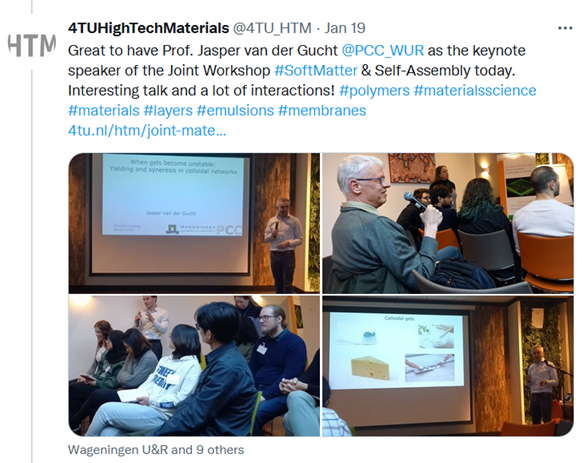
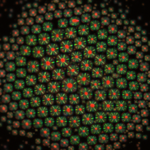 Check his work and group at the website:
Check his work and group at the website: "Colloids are not only fun to study but also beautiful", and therefore, instagrammable!
"Colloids are not only fun to study but also beautiful", and therefore, instagrammable! Follow our speakers on Twitter:
Follow our speakers on Twitter: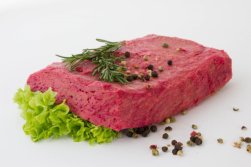 Listen to Atze Jan van der Goot
Listen to Atze Jan van der Goot 